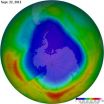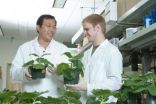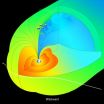(Press-News.org) A multinational research team has discovered filamentous bacteria that function as living power cables in order to transmit electrons thousands of cell lengths away.
The Desulfobulbus bacterial cells, which are only a few thousandths of a millimeter long each, are so tiny that they are invisible to the naked eye. And yet, under the right circumstances, they form a multicellular filament that can transmit electrons across a distance as large as 1 centimeter as part of the filament's respiration and ingestion processes.
The discovery by scientists at Aarhus University in Denmark and USC will be published in Nature on October 24.
"To move electrons over these enormous distances in an entirely biological system would have been thought impossible," said Moh El-Naggar, assistant professor of physics at the USC Dornsife College of Letters, Arts and Sciences, and co-author of the Nature paper.
Aarhus scientists had discovered a seemingly inexplicable electric current on the sea floor years ago. The new experiments revealed that these currents are mediated by a hitherto unknown type of long, multicellular bacteria that act as living power cables
"Until we found the cables we imagined something cooperative where electrons were transported through external networks between different bacteria. It was indeed a surprise to realize, that it was all going on inside a single organism," said Lars Peter Nielsen of the Aarhus Department of Bioscience, and a corresponding author of the Nature paper.
The team studied bacteria living in marine sediments that power themselves by oxidizing hydrogen sulfide. Cells at the bottom live in a zone that is poor in oxygen but rich in hydrogen sulfide, and those at the top live in an area rich in oxygen but poor in hydrogen sulfide.
The solution? They form long chains that transport individual electrons from the bottom to the top, completing the chemical reaction and generating life-sustaining energy.
"You have feeder cells on one end and breather cells on the other, allowing the whole living cable to survive," El-Naggar said.
Aarhus and USC researchers collaborated to use physical techniques to evaluate the long-distance electron transfer in the filamentous bacteria. El-Naggar and his colleagues had previously used scanning-probe microscopy and nanofabrication methods to describe how bacteria use nanoscale structures called "bacterial nanowires" to transmit electrons many body lengths away from cells.
"I'm a physicist, so when I look at remarkable phenomena like this, I like to put it into a quantifiable process," El-Naggar said.
El-Naggar, who was just chosen as one of the Popular Science Brilliant 10 young scientists for his work in biological physics, said physicists are increasingly being tapped to tackle tough biological questions.
"This world is so fertile right now," he said. "It's just exploding."
###
This research was funded by European Research Council, the Danish National Research Foundation, the Danish Foundation for Independent Research and the German Max Planck Society.
Living power cables discovered
Multicellular bacteria transmit electrons across relatively enormous distances
2012-10-25
ELSE PRESS RELEASES FROM THIS DATE:
Americans use more efficient and renewable energy technologies
2012-10-25
Americans used less energy in 2011 than in the previous year due mainly to a shift to higher-efficiency energy technologies in the transportation and residential sectors. Meanwhile, less coal was used but more natural gas was consumed according to the most recent energy flow charts released by Lawrence Livermore National Laboratory.
Wind power saw the biggest jump from .92 quadrillion BTU, or quads, in 2010 up to 1.17 quads in 2011. (BTU or British Thermal Unit is a unit of measurement for energy and is equivalent to about 1.055 kilojoules).
"Wind energy jumped significantly ...
U of A medical researchers use simple intervention to improve osteoporosis treatment rates
2012-10-25
Older patients who visited local ERs for chest pain or breathing problems and had chest x-rays reveal unknown spinal fractures, were more apt to receive osteoporosis treatment afterward if a simple intervention was used, recently published medical research from the University of Alberta has found.
Treatment rates for the bone-thinning condition substantially improved when patients and their family doctors received follow-up information about the warning signs and risk factors. It is the first and only trial in the world that looked at spinal osteoporosis.
Of those ...
Pigs look healthy but test positive for flu at fairs; transmission seen between pigs and humans
2012-10-25
COLUMBUS, Ohio – More than 80 percent of pigs that tested positive for influenza A virus at Ohio county fairs between 2009 and 2011 showed no signs of illness, according to a new study.
Ohio State University researchers tested 20 pigs each at 53 fair events over those three summers and found at least one flu-positive pig at 12 fairs – almost a quarter of fairs tested.
The influenza strains identified in pigs in this study include H1N2 and H3N2 viruses – strains that have been circulating in pigs since 1998. In 2011, all of the H3N2 and H1N2 isolates found in pigs ...
Which candidate will be best for the stock market...?
2012-10-25
DeKALB, Ill. -- With Election Day less than a month away, television is filled with talking heads spreading the conventional wisdom of what a Republican or Democratic president might mean for the economy.
However, a group of researchers says, when it comes to the relationship between presidential politics and the behavior of the financial markets, conventional wisdom may not be so wise.
The researchers reviewed more than 40 years of data (1965-2008) in studying the relationship between security returns and four variables: the political affiliation of the president; ...
CU-Boulder researchers uncover new target for cancer research
2012-10-25
In a new paper released today in Nature, BioFrontiers Institute scientists at the University of Colorado Boulder, Tom Cech and Leslie Leinwand, detailed a new target for anti-cancer drug development that is sitting at the ends of our DNA.
Researchers in the two scientists' laboratories collaborated to find a patch of amino acids that, if blocked by a drug docked onto the chromosome end at this location, may prevent cancerous cells from reproducing. The amino acids at this site are called the "TEL patch" and once modified, the end of the chromosome is unable to recruit ...
2012 Antarctic ozone hole second smallest in 20 years
2012-10-25
WASHINGTON -- The average area covered by the Antarctic ozone hole
this year was the second smallest in the last 20 years, according to
data from NASA and National Oceanic and Atmospheric Administration
(NOAA) satellites. Scientists attribute the change to warmer
temperatures in the Antarctic lower stratosphere.
The ozone hole reached its maximum size Sept. 22, covering 8.2 million
square miles (21.2 million square kilometers), or the area of the
United States, Canada and Mexico combined. The average size of the
2012 ozone hole was 6.9 million square miles (17.9 ...
Plants provide accurate low-cost alternative for diagnosis of West Nile Virus
2012-10-25
While the United States has largely been spared the scourge of mosquito-borne diseases endemic to the developing world—including yellow fever, malaria and dengue fever—mosquito-related illnesses in the US are on the rise. One pathogen of increasing concern in the U.S. is an arbovirus known as West Nile.
Now Qiang "Shawn" Chen, a researcher at Arizona State University's Biodesign Institute and a professor in the College of Technology and Innovation has developed a new method of testing for West Nile, using plants to produce biological reagents for detection and diagnosis. ...
NASA study using cluster reveals new insights into solar wind
2012-10-25
A new study based on data from European Space Agency's Cluster mission shows that it is easier for the solar wind to penetrate Earth's magnetic environment, the magnetosphere, than had previously been thought. Scientists from NASA's Goddard Space Flight Center in Greenbelt, Md. have, for the first time, directly observed the presence of certain waves in the solar wind—called Kelvin-Helmholtz waves that can help transfer energy into near-Earth space—under circumstances when previous theories predicted they were not expected.
The recent paper, published on Aug 29, 2012, ...
Galaxy halos are produced by orphan stars, findings indicate
2012-10-25
Irvine, Calif., Oct. 24, 2012 – Isolated stars kicked to the edges of space by violent galaxy mergers may be the cause of mysterious infrared light halos observed across the sky, according to UC Irvine and other astronomers.
"Background glow in our sky has been a huge unanswered question," said UCI physics & astronomy professor Asantha Cooray, lead author of a paper about the discovery in the Oct. 25 issue of the journal Nature. "We have new evidence that this light is from stars that linger between galaxies. Individually, they're too dim to be seen, but we think we're ...
Video game with biofeedback teaches children to curb their anger
2012-10-25
Boston, Mass. , Oct. 24, 2012—Children with serious anger problems can be helped by a simple video game that hones their ability to regulate their emotions, finds a pilot study at Boston Children's Hospital. Results were published online October 24 in the journal Adolescent Psychiatry.
Noticing that children with anger control problems are often uninterested in psychotherapy, but very eager to play video games, Jason Kahn, PhD, and Joseph Gonzalez-Heydrich, MD, at Boston Children's Hospital developed "RAGE Control" to motivate children to practice emotional control skills ...
LAST 30 PRESS RELEASES:
Scientists use ultrasound to soften and treat cancer tumors without damaging healthy tissue
Community swimming program for Black youth boosts skills, sense of belonging, study finds
Specific depressive symptoms in midlife linked to increased dementia risk
An ‘illuminating’ design sheds light on cholesterol
Who is more likely to get long COVID?
Study showcases resilience and rapid growth of “living rocks”
Naval Research Lab diver earns Office of Naval Research 2025 Sailor of the Year
New Mayo-led study establishes practical definition for rapidly progressive dementia
Fossil fuel industry’s “climate false solutions” reinforce its power and aggravate environmental injustice
Researchers reveal bias in a widely used measure of algorithm performance
Alcohol causes cancer. A study from IOCB Prague confirms damage to DNA and shows how cells defend against it
Hidden viruses in wastewater treatment may shape public health risks, study finds
Unlock the power of nature: how biomass can transform climate mitigation
Biochar reshapes hidden soil microbes that capture carbon dioxide in farmland
Reducing saturated fat intake shows mortality benefit, but only in high-risk individuals
Manta rays create mobile ecosystems, study finds
Study: Mixed results in using lipoic acid to treat progressive multiple sclerosis
Norbert Holtkamp appointed director of Fermi National Accelerator Laboratory
New agentic AI platform accelerates advanced optics design
Biologists discover neurons use physical signals — not electricity — to stabilize communication
Researchers discover that a hormone can access the brain by hitchhiking
University of Oklahoma researcher awarded funding to pursue AI-powered material design
Exploring how the visual system recovers following injury
Support for parents with infants at pediatric check-ups leads to better reading and math skills in elementary school
Kids’ behavioral health is a growing share of family health costs
Day & night: Cancer disrupts the brain’s natural rhythm
COVID-19 vaccination significantly reduces risk to pregnant women and baby
The role of vaccination in maternal and perinatal outcomes associated with COVID-19 in pregnancy
Mayo Clinic smartwatch system helps parents shorten and defuse children's severe tantrums early
Behavioral health spending spikes to 40% of all children’s health expenditures, nearly doubling in a decade
[Press-News.org] Living power cables discoveredMulticellular bacteria transmit electrons across relatively enormous distances


